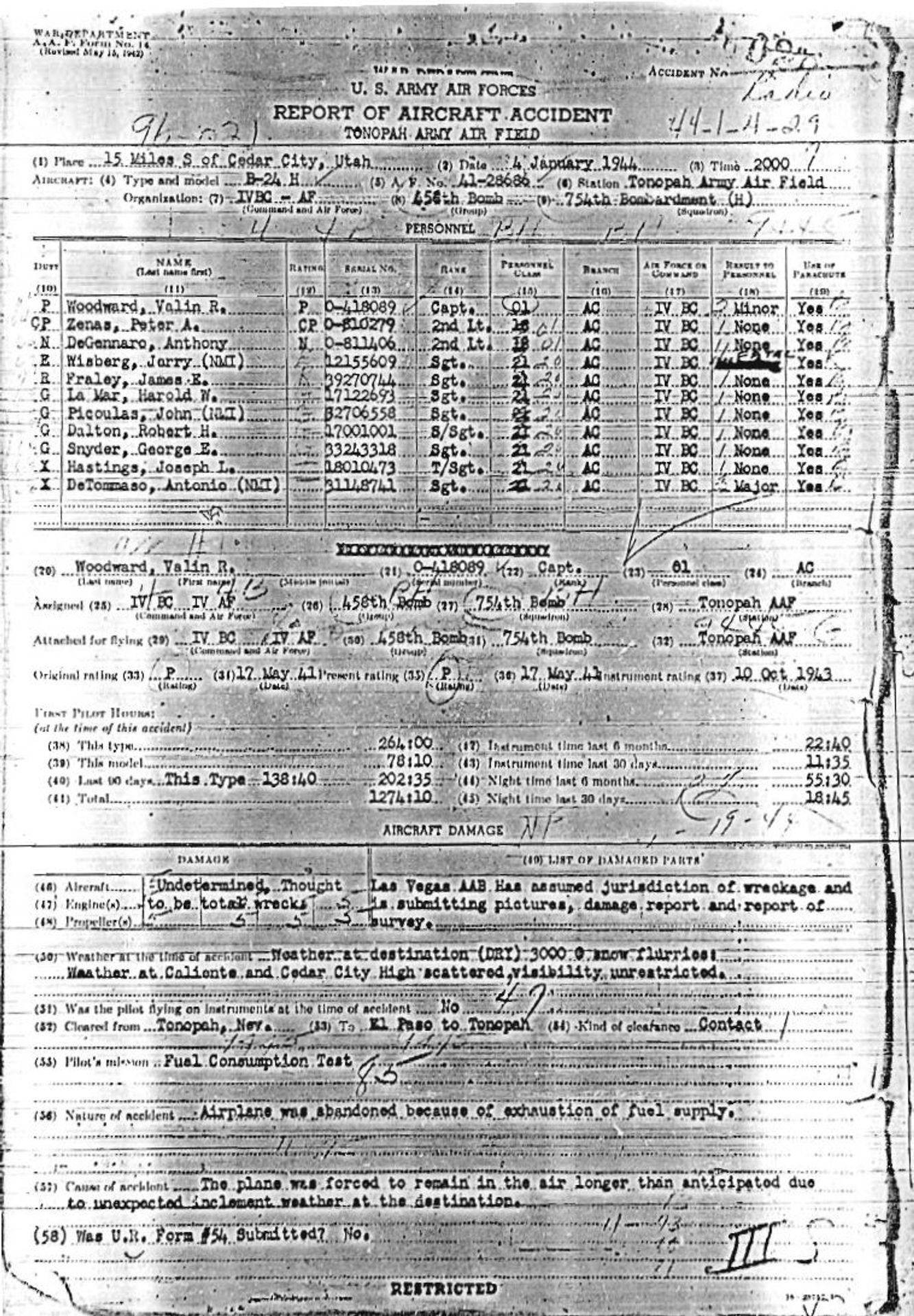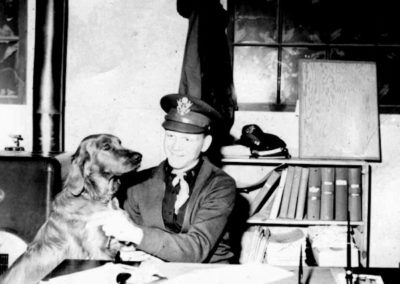Crew 41- Assigned 754th Squadron – October 1943
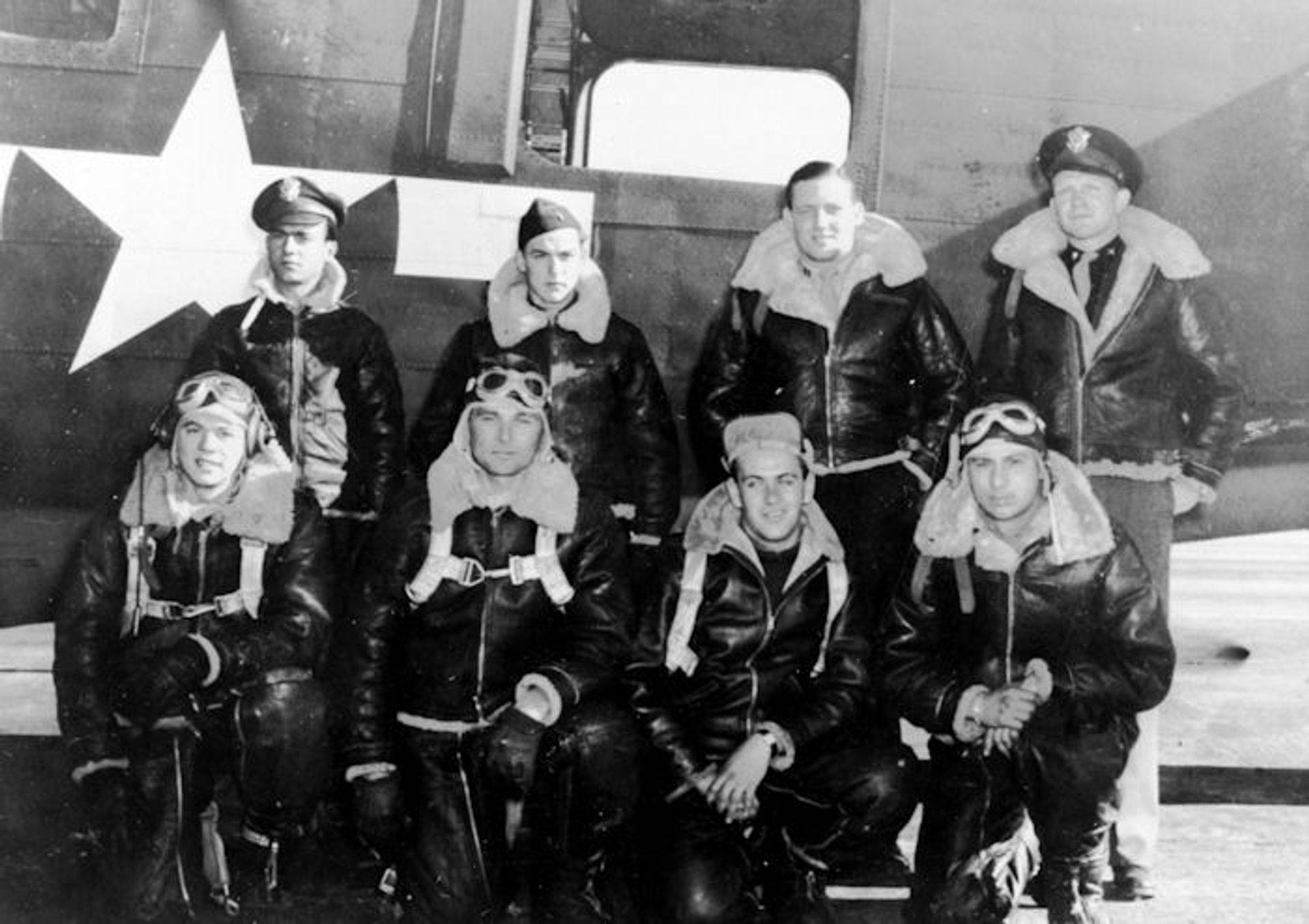
Not pictured: George Snyder – 2E/TTG, Raymond Peters – TG
Completed Tour
| Rank | Name | Serial # | Pos | Date | Status | Comments |
|---|---|---|---|---|---|---|
| Maj | Valin R Woodward | 0418089 | Pilot / Sqdn CO | Mar-45 | CT | Assumes command of 755th Sqdn |
| 1Lt | Peter A Zenas | 010279 | Co-pilot | Jul-44 | CT | Awards - Distinguished Flying Cross |
| 1Lt | Bill Cain | 0673039 | Bombardier | Aug-44 | CT | Awards - Distinguished Flying Cross |
| 1Lt | Anthony J DeGennaro | 0811406 | Navigator | Aug-44 | CT | Awards - Distinguished Flying Cross |
| Sgt | Jerry Weisberg | 12155609 | Flight Engineer | 04-Jan-44 | DNB | Bail out Cedar City, UT - Chute failed |
| T/Sgt | James E Fraley | 39270744 | Radio Operator | Aug-44 | CT | Awards - Distinguished Flying Cross |
| T/Sgt | Harold W LaMar | 17127693 | Flight Engineer | Sep-44 | CT | Awards - Distinguished Flying Cross |
| Sgt | George E Snyder | 33243318 | Aerial Gunner/2E | 06-Jun-44 | UNK | Mission Load List |
| Pfc | Raymond O Peters | 39692006 | Airplane Armorer | 05-Jul-44 | RFS | Reld from 60SC (MOS 911) |
| Pvt | John Picoulas | 32706558 | Armorer-Gunner | 03-Jul-44 | RFS | Trsf to 2912th Disp Trng Ctr |
Captain Woodward’s crew went through a series of personnel changes from almost the beginning of their formation as a crew. At Gowen Field, Idaho, in early October 1943 all of the men listed above, except for Lt’s DeGennaro and Zenas were put together as a crew. 2Lt Fred E. Stone was the original co-pilot, but his place was soon taken by 2Lt Peter A. Zenas. It is believed that Lt Stone went on to fly in the 44th BG. 2Lt Anthony J. DeGennaro, navigator, was assigned to the crew during October 1943.
The next crew change occurred on January 4, 1944 under tragic circumstances. Sgt Jerry Weisberg was killed on a training flight (see below) and Sgt George E. Snyder took his place as engineer. Sgt Robert H. Dalton was also assigned to the crew to fill the empty slot as tail gunner prior to the crew departing for the ETO. Woodward’s crew brought a brand new B-24J over from the States, B-24J-95-CO 42-100366 Z5 B, they named this ship Mizpah and flew 21 missions of their tour in this aircraft. The crew arrived a little later than most due to their training accident and they flew their first mission on March 15, 1944 to Brunswick, Germany. The majority of Crew 41’s missions were flown as group lead or deputy lead.
Records are not clear, but it appears that most of the crew completed their missions in July or August 1944. Two exceptions were Sgt John Picoulas and Sgt Raymond O. Peters. According to co-pilot, Pete Zenas, shortly after experiencing combat, Picoulas became reluctant to enter the ball turret on subsequent missions. He traded with another gunner for a waist gun, but that did not work out either. Robert Dalton was elected crew spokesman for the gunners and spoke to Zenas about the problem. Zenas and Picoulas discussed the matter and came to the mutual conclusion that Picoulas be removed from the crew and assigned ground duties. It is believed that Raymond Peters requested ground duties as well. Both men were reduced to the grade of Private in May or June 1944. Peters was assigned to the 60th Station Complement and eventually regained the rank of Private First Class. Picoulas evidently had additional difficulties on the ground as he was transferred to the 2912th Disciplinary Training Center at Long Ashton on July 3, 1944. One of the positions vacated by the two gunners was filled by S/Sgt Daniel W. Hayes, a gunner from 2Lt Thayer Hopkins Crew 48. Hopkins went down on the March 6, 1944 Berlin raid, but Hayes did not fly that day. The other vacancy was taken by T/Sgt Young (first name unknown).
Lt Degennaro was wounded on the March 16th mission to Friedrichshafen Germany. The extent or nature of his injuries are unknown. He was awarded the Purple Heart in April.
1Lt Peter Zenas is shown flying one mission as Airplane Commander (1st pilot) on July 2, 1944.
In September 1944 Captain Woodward became the Assistant Station/Group S3, was promoted to Major and flew several missions as Command Pilot. In November he was transferred to the 755th Squadron and became their Operations Officer. Shortly thereafter, in December he was rotated back to the States. On March 11, 1945 Major Woodward returned to the 458th and took over as Squadron Commander of the 755th Squadron. He replaced Lt Col Donald C. Jamison who had been the 755th’s CO since late 1943 in Tonopah. Maj Woodward flew several additional missions as Command Pilot before the war ended. On August 22, 1945, after what remained of the 458th Bomb Group returned to the States, Major Woodward was appointed the Group Commander. He was to be the last CO of the 458th before the group was deactivated on September 12, 1945.
Missions – Valin Woodward as Pilot & Command Pilot
| Date | Target | 458th Msn | Pilot Msn | Cmd Pilot | Ld | Serial | RCL | Sqdn | A/C Msn | A/C Name | Comments |
|---|---|---|---|---|---|---|---|---|---|---|---|
| 15-Mar-44 | BRUNSWICK | 7 | 1 | 42-100407 | A | J3 | 1 | LITTLE LAMBSY DIVEY | |||
| 16-Mar-44 | FRIEDRICHSHAFEN | 8 | 2 | HINCKLEY | D2 | 42-100362 | A | Z5 | 6 | SWEET LORRAINE/BOOMERANG | |
| 21-Mar-44 | WATTEN, near ST. OMER | 10 | 3 | 42-100357 | D | Z5 | 4 | VALE OREGAN | |||
| 26-Mar-44 | BONNIERES | 14 | 4 | L2 | 42-100366 | M | Z5 | 4 | MIZPAH | ||
| 05-Apr-44 | ST. POL-SIRACOURT | 16 | 5 | HINCKLEY | D1 | 42-100366 | B | Z5 | 5 | MIZPAH | |
| 08-Apr-44 | BRUNSWICK/WAGGUM | 17 | 6 | 42-100366 | B | Z5 | 6 | MIZPAH | |||
| 09-Apr-44 | TUTOW A/F | 18 | 7 | HENSLER | L2 | 42-100366 | B | Z5 | 7 | MIZPAH | |
| 11-Apr-44 | OSCHERSLEBEN | 20 | 8 | ISBELL | L1 | 42-100366 | B | Z5 | 8 | MIZPAH | Gen PECK also listed |
| 18-Apr-44 | BRANDENBURG | 22 | 9 | HINCKLEY | D2 | 42-100366 | B | Z5 | 10 | MIZPAH | |
| 20-Apr-44 | SIRACOURT | 24 | 10 | HOGG | L1 | 42-100366 | B | Z5 | 11 | MIZPAH | NAV - ROGENMUSER |
| 25-Apr-44 | MANNHEIM A/F | 27 | NTO | WRIGHT | D1 | 42-100366 | B | Z5 | -- | MIZPAH | NAV MARCHAND |
| 26-Apr-44 | PADERBORN A/F | 28 | 11 | 42-100366 | B | Z5 | 13 | MIZPAH | |||
| 27-Apr-44 | BONNIERES | 29 | 12 | HENSLER | L2 | 42-110172 | D | Z5 | 1 | UNKNOWN 017 | NAV - ROGENMUSER |
| 27-Apr-44 | BLAINVILLE-SUR-L'EAU M/Y | 30 | 13 | 42-110172 | D | Z5 | 2 | UNKNOWN 017 | |||
| 01-May-44 | MARQUISE/MIMOYECQUES | 32 | 14 | HOGG | L1 | 42-100366 | B | Z5 | 14 | MIZPAH | SAWYER - LEAD NAV |
| 01-May-44 | LIEGE M/Y | 33 | 15 | HOGG | L1 | 42-100408 | D | J4 | 10 | LADY LUCK / THE BEAST | SAWYER - LEAD NAV |
| 07-May-44 | OSNABRUCK | 36 | 16 | 42-100366 | B | Z5 | 15 | MIZPAH | |||
| 13-May-44 | TUTOW A/F | 41 | 17 | HOGG | L | 42-100366 | B | Z5 | 17 | MIZPAH | PETERS (LEAD NAV) |
| 23-May-44 | BOURGES | 45 | 18 | 42-100366 | B | Z5 | 19 | MIZPAH | |||
| 24-May-44 | VILLEROCHE, near MELUN | 46 | 19 | SCHWARTZ | L2 | 42-100366 | B | Z5 | 20 | MIZPAH | CAIN (LEAD BOMB) |
| 28-May-44 | ZEITZ | 49 | 20 | L2 | 42-100366 | B | Z5 | 22 | MIZPAH | NAV - DALY | |
| 31-May-44 | BERTRIX | 52 | 21 | 42-100366 | B | Z5 | 24 | MIZPAH | DALY (LEAD NAV) | ||
| 04-Jun-44 | BOURGES A/F | 54 | 22 | L1 | 42-100366 | B | Z5 | 25 | MIZPAH | ||
| 06-Jun-44 | VILLERS BOCAGE | 57 | 23 | FREEMAN | L1 | 42-100366 | B | Z5 | 26 | MIZPAH | MSN #2 |
| 10-Jun-44 | CHATEAUDUN | 61 | 24 | WILLIAMS | D1 | 42-100366 | B | Z5 | 27 | MIZPAH | |
| 12-Jun-44 | EVREUX/FAUVILLE | 64 | 25 | HINCKLEY | L2 | 42-100366 | B | Z5 | 28 | MIZPAH | |
| 15-Jun-44 | GUYANCOURT | 66 | 26 | HINCKLEY | D1 | 42-100366 | B | Z5 | 29 | MIZPAH | |
| 06-Jul-44 | KIEL | 85 | ABT | 42-100366 | B | Z5 | -- | MIZPAH | TAIL VIBRATION | ||
| 08-Jul-44 | ANIZY, FRANCE | 87 | 27 | LaROCHE | L1 | 42-100366 | B | Z5 | 30 | MIZPAH | HINCKLEY ALSO LISTED |
| 01-Aug-44 | T.O.s FRANCE | 100 | 28 | WOODWARD | L2 | 42-50499 | F | 7V | 3 | COOKIE/OPEN POST | Pilot WEBER |
| 08-Aug-44 | CLASTRES | 108 | 29 | WOODWARD | L2 | 42-50499 | F | 7V | 4 | COOKIE/OPEN POST | Pilot J. ROBERTS |
| 12-Aug-44 | MOURMELON | 111 | 30 | WOODWARD | L2 | 44-10487 | B | 7V | 4 | Girl on surfboard (no name) | Pilot HAYZLETT |
| 05-Sep-44 | KARLSRUHE | 122 | 31 | WOODWARD | D1 | 42-95609 | T | T9 | -- | 466BG/784SQ | PFF 466BG - Pilot PURCELL |
| 19-Sep-44 | HORSHAM to CLASTRES | TR03 | -- | 42-95108 | M | J3 | T3 | ENVY OF 'EM ALL II | CARGO (Cook) | ||
| 23-Sep-44 | HORSHAM to ST DIZIER | TR07 | -- | 41-29276 | G | Z5 | T5 | URGIN VIRGIN/The ROTTEN SOCK | CARGO | ||
| 24-Mar-45 | KIRKOFF | 213 | 32 | WOODWARD | L3 | 44-49910 | D | J3 | 5 | UNKNOWN 044 | Pilot MORAN |
| 05-Apr-45 | PLAUEN | 218 | 33 | WOODWARD | L2 | 42-51669 | J | J3 | 27 | UNKNOWN 026 | Pilot HATHORN |
| 18-Apr-45 | PASSAU | 228 | 34 | WOODWARD | D1 | 44-50892 | N | J3 | 5 | UNKNOWN 055 | Pilot R. SHAW |
Tonopah, Nevada

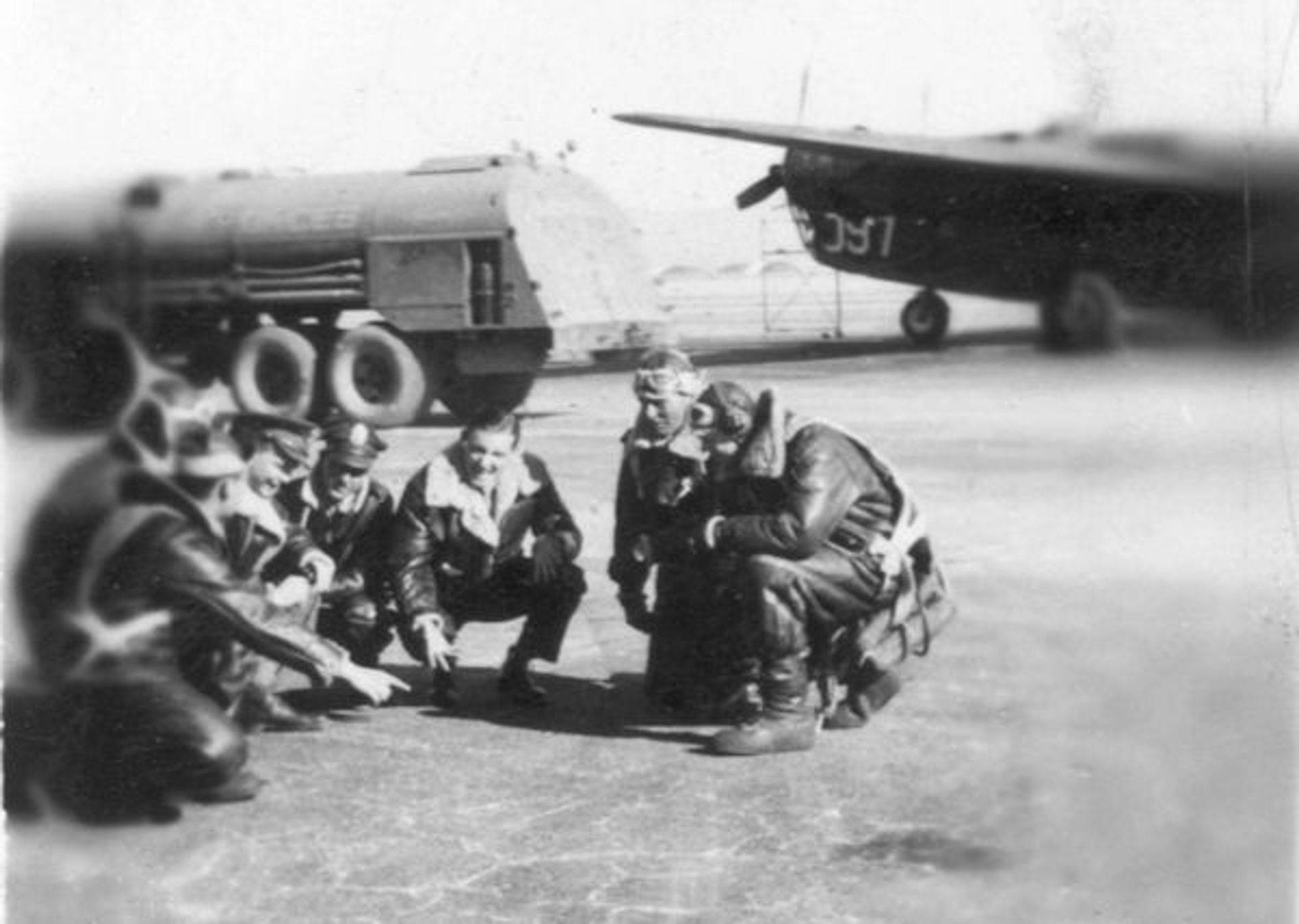
Photos: Pete Zenas
January 4, 1944
NARRATIVE
On returning to Tonopah after an eight hour fuel consumption mission to El Paso the pilot encountered low ceilings and snow flurries when within five minutes of the destination at approximately 1915. After initial radio contact with the tower the pilot was unable to maintain contact due to radio interference. The pilot has stated that he made several unsuccessful attempts to get a destination weather report while enroute. After failing to maintain contact with the tower the pilot attempted to make an instrument let down, but was unable to follow the beam because of snow static. Failing in his attempt to make an instrument let down the pilot decided to try and reach Las Vegas or some other landing field along the light line running from Las Vegas to Enterprise. After climbing out of the overcast at 18500 ft. the pilot determined that the weather looked clearer in the vicinity of Enterprise, so he decided to attempt a landing at Cedar City, Utah. Upon reaching Caliente, Nevada he realized that his gas supply was too low to reach Cedar City safely so he circled Caliente and bailed his crew out upwind from the city. The pilot and co-pilot then headed for Cedar City but were forced to bail out approximately fifteen miles short of Cedar City, when the fuel supply was completely exhausted and all four engines had stopped. One member of the crew, Sgt. Wisberg [sic], is known to have cleared the plane safely, but his parachute was not seen to open, and he has not yet been located. All other crew members have been found, and the only serious injury was broken leg suffered by Sgt. DeTommaso. Sgt. DeTommaso is at present confined to the station hospital at Las Vegas, Nevada. The airplane has been located fifteen miles south of Cedar City, Utah.
RESPONSIBILITY
In the opinion of the board this accident was the result of the pilot encountering inclement weather, which could not reasonably have been foreseen over his point of destination. The pilot made several unsuccessful attempts while enroute to obtain a destination weather report; and since the weather was CAVU until just before he reached his destination the pilot had no reason to suspect that he would encounter any difficulty.
RECOMMENDATIONS
None.
Statements from Accident Report 44-01-04-29
Capt Valin R. Woodward – Pilot
We departed Tonopah Army Air Field 1043. We were on a fuel consumption test. The trip proceeded to El Paso, Texas without incident. We circled El Paso, Texas and departed for Tonopah Army Air Field. We were directly on course when we passed the airline between Las Vegas and Ely. Just previous to this we had passed over a very thin stretch of broken clouds lasting some ten miles. At or about this time although there was no indication of any weather at all I tried for some minutes to contact Las Vegas tower. At one time during this attempt I heard the woman in the Las Vegas tower giving instructions to an incoming plane. However I was unable to contact her. I then tried Acomita radio and Albuquerque radio respectively. We were evidently too far to contact them. It was getting dark at this time so I climbed to 18,000 feet and proceeded on course to Tonopah. The weather at this point as far as I could see ahead was CAVU. Approximately thirty minutes out of Tonopah we tuned in the Tonopah Range, received the “A” quadrant signal with a slight background. We were slightly to the right of the SE leg of the beam. I called the navigator, checked the course and asked him if he saw the beacon. He said he did not but that we should see it soon. He said he had a five minute ETA, but that we might be a few minutes late because of strong headwinds. About three minutes from this time I encountered a hazy condition, made another attempt to raise Tonopah Tower. I got in contact with the tower. The tower reported a 3,000 foot ceiling with snow. I switched back to the radio range and got an “A” quadrant signal with a very strong background. I then lost all legible radio contact. I turned to the heading of 270 degrees and held this heading. I attempted to pick up the range with my radio compass. This proved to be no better. I held this heading until I was sure we were well passed the field. I started a slow circle to the left. I circled the area for approximately ten or fifteen minutes letting down at 14,500 feet endeavoring to contact the tower but had no success. I then took up a heading of east and climbed out of the weather at 18,500 feet. I again called the tower, contacted them successfully, reported that I was low on fuel and oxygen and I would attempt to fly a reciprocal heading and make Las Vegas. If this failed I would bail my crew out. This is the first complete communication I had had with the tower except for one break when I heard the tower call and make an attempt to tell me where the edge of the overcast was. I received the information the tower relayed at this time. I then repeated my plan to the tower to try to reach the auxiliary landing field and if this failed I would bail my crew out. I was unable to see Las Vegas but could very clearly see the light line and the flashing green beacon at Cedar City. I had figured on an hour and 20 to 30 minutes of gasoline when I left Tonopah, but at 2000 the gas supply was so low that I deemed it advisable to bail the crew out while we still had time to do it in an orderly manner. I sent all the crew to the rear of the ship. I had the co-pilot take over while I briefed the radio man on procedure for getting the men out. I used the radio man because he seemed to have the levelest head and stuck right by me tuning in stations as fast as I asked for them. He then went to the rear of the ship, got on the interphone and I directed the bail out from the pilot’s seat through him. He reported to me as each man went out and whether they cleared the ship successfully or not. After the last man went out he then reported that he was jumping. I bailed the crew out upwind of the town of Caliente between a highway and a railroad forming a point at the town.
I completed a circle of the town and for a point some 25 miles SE of Caliente, I headed directly for the green beacon at Cedar City. We were in very plain sight of the field at Cedar City when the #1 engine quit. I feathered this engine. About 3 seconds later the #3 engine quit. Some 50 to 60 seconds later the #2 engine quit. The co-pilot had previously opened the nose wheel door. We both proceeded to the bombardier’s compartment. The co-pilot bailed out. I followed him just as the last engine quit. I landed on top of a mountain in a clump of trees which was some 15 miles SE of Cedar City. I got out of my harness by letting myself down with my hands and shaking free of my leg straps. I made my way down the side of the mountain and joined my co-pilot on a ranger trail. He guided me down the mountain with a flashlight. We then waded through snow down this trail 15 miles to a highway where we were picked up and carried to Cedar City where I contacted Base Operations.
2Lt Peter A. Zenas – Co-pilot
We departed Tonopah Army Air Field at 1045 on January 4, 1944 on fuel consumption mission to El paso, Texas. The trip to El Paso was uneventful and weather conditions were ideal for the flight. On the return trip to Tonopah the weather was still good. We were on course at Las Vegas and tried to contact Las Vegas Radio and Tower for weather reports for Tonopah. We could hear Las Vegas, but evidently they could not read us. The weather looked clear ahead. The navigator reported to the pilot that our position was approximately 5 minutes out of Tonopah and that the beacon should be visible. Just about then we encountered what appeared to be a light haze, because the ground and sky were visible. Then suddenly we were “socked in” completely and the radio range beam which we were flying went out due to the ice striking the antenna. We tried to contact the control tower, but couldn’t receive the tower. We tried Las Vegas and Albuquerque and a couple of other stations but failed to get an answer. We finally did succeed in getting an answer from Tonopah stating that the ceiling was 3,000 feet with snow flurries. We lost contact again. We then tried to pick up the range again with no success due to static. After several tries to break through the weather and get radio contact we picked up a reciprocal heading which would take us to Las Vegas. Realizing that fuel was low, we headed east toward the light line. After we had let down to 14,500 feet, we began to climb to get out of the overcast. We broke through at about 18,000 feet. Then we saw the towns of Caliente and Panaca. Our fuel supply was just about exhausted so we had the whole crew except Capt. Woodward and myself go to the waist position to prepare for bail out through the camera hatch. Getting our wind direction we made a half circle to the upwind side of Panaca and Caliente; keeping Sgt. Fraley, radio operator on the interphone. The order was given to bail out starting with Picoulas, then Degennaro, then La Mar, De Tommaso, Snyder, Wisberg [sic], Hastings and last Fraley. Before ordering the crew to jump instructions were given for proper bail out and safety precautions on landing and to keep the town in sight and walk to it. The first one to reach town was instructed to call the base at Tonopah. After Fraley said the last boy had jumped and that he was leaving, we called back several times to make sure that he wasn’t there. We headed towards the Cedar City light beacon. We decided to stay with the ship until the gas ran out in the hopes of making the field at Cedar City. I had flashed the landing lights and also tried to get radio contact with the ground. Before the crew bailed out we had lowered the landing gear to slow the ship up as much as possible, and after the last man left we pulled the gear up and I went down and opened the emergency nose wheel door. Returning to the cockpit I gave a MAYDAY call stating we were out of gas and had bailed our crew out and were ready to leave the ship also. We were a few miles out of Cedar City when the engines started going out one after the other. After putting the ship on auto pilot we went down to the nose and I bailed out and was immediately followed by Capt. Woodward. I made a successful landing and picked up Capt. Woodward shortly afterwards. We walked ‘down’ the mountain road and then caught a ride into town on the main highway. After getting medical attention in town and reporting to Tonopah, we received a call from Panaca stating that Fraley, Snyder and De Gennaro had made town. We then learned from Fraley that Dalton had left the ship approximately ten minutes before the order to bail out and had jumped feet first striking the side of the camera hatch, and no one saw his chute open. No one saw Wisberg’s chute open when he baled out.


2Lt Anthony J. DeGennaro – Navigator
We were on a fuel consumption mission from Tonopah to El Paso and return to Tonopah. The plane was fully loaded with baggage for the weight requirement of the mission. Take-off was between 1045 and 1100. The flight to El Paso was uneventful – weather conditions were ideal. We circled El Paso a few times and started back. We had a semi headwind retarding ground speed. We were on course about 15 miles east of Las Vegas and the weather was clear all the way up to this point. We flew on towards Tonopah and encountered light haze but the weather was still contact. When we were about 15 miles southeast of Tonopah, the pilot asked for an E.T.A. About five minutes before that, we had run into low ceilings and prime icing conditions. We were at 16,000 feet and I advised the pilot to let down as the beacon at the field should be visible because the E.T.A. was five minutes. At the expiration of my E.T.A. and with a possible error of two minutes, the pilot began circling, and I had the nose turret gunner keep watch for the beacon. I was also watching. All during this time the pilot and radio man were trying to make contact. After we had circled, I went up to the flight deck and found out the situation concerning the gas supply. The pilot asked me for a heading to Las Vegas. Not knowing the exact position because of the weather conditions, we flew a reciprocal heading. We didn’t think that we could make Las Vegas with the amount of gas left, so the pilot ordered the crew to the waist position to await orders to bail out. He then headed toward the light line between Las Vegas and Salt Lake City. We knew that emergency fields were situated along that light line. At the waist I awaited orders to bail out. I followed Sgt. Picoulas and made a successful landing and was uninjured. I walked towards the lights of the town. I jumped at approximately 1955. I realized that the town was too far away so I walked towards the car lights on the road which were apparently searching. I was picked up at approximately 2400, and then taken into Caliente. I gave information to the searching parties which might aid in finding the other crew members.
Sgt Harold W. LaMar – Flight Engineer
We were on a fuel consumption mission returning from El Paso, Texas. Upon approaching the Tonopah Army Air Field, we ran into low ceilings. Fog, mist and icing conditions surrounded us. Our gas supply was nearly exhausted; radio contact with ground stations practically nil. Approximately 2000, Capt. Woodward gave us the order to bail out. Capt. Woodward flew us in a line with a town from which we could see the lights after we bailed out. From this position it was a simple matter to walk toward the lights.
Sgt George E. Snyder – Top Turret Gunner
We were returning from a fuel consumption mission. As we neared Tonopah, I heard the Control Tower give the ceiling as 3,000 feet. We circled for some time and couldn’t find any sign of the field. Our fuel was running low. I was in the waist position of the plane when the pilot gave orders to prepare to bail out. We were all prepared when the pilot gave the order to bail out. I took my jump at about 2000.
Sgt John Picoulas – Ball Turret Gunner
We were coming back to our home base, completing a fuel consumption test, when we ran into a low overcast. We flew around in the overcast for a few hours, but we couldn’t get out of it. Our fuel was running low, so the pilot told us to prepare to bail out. We waited for the word to go and I bailed out at about 2000.
Sgt Robert H. Dalton – Tail Gunner
The following is a brief account of the aircraft discrepancy I was involved in on the 4th of January 1944 at 2000.
The plane, a B-24H, and crew of nine plus two additional passengers was returning from a flight that originated at Tonopah – non stop to El Paso, Texas and was to have ended at Tonopah, Nevada, the home base. As we approached the Tonopah area the visibility became very poor. At this time several unsuccessful attempts were made to contact the radio tower at Tonopah.
Finally the visibility became absolutely zero and the pilot decided to continue on to Las Vegas. After flying for another period of time, number 3 engine quit. Shortly afterwards the pilot gave the order to bail out and also rang the warning bell. I immediately jumped. The altitude was approximately 20,000 feet.
This is a true statement.

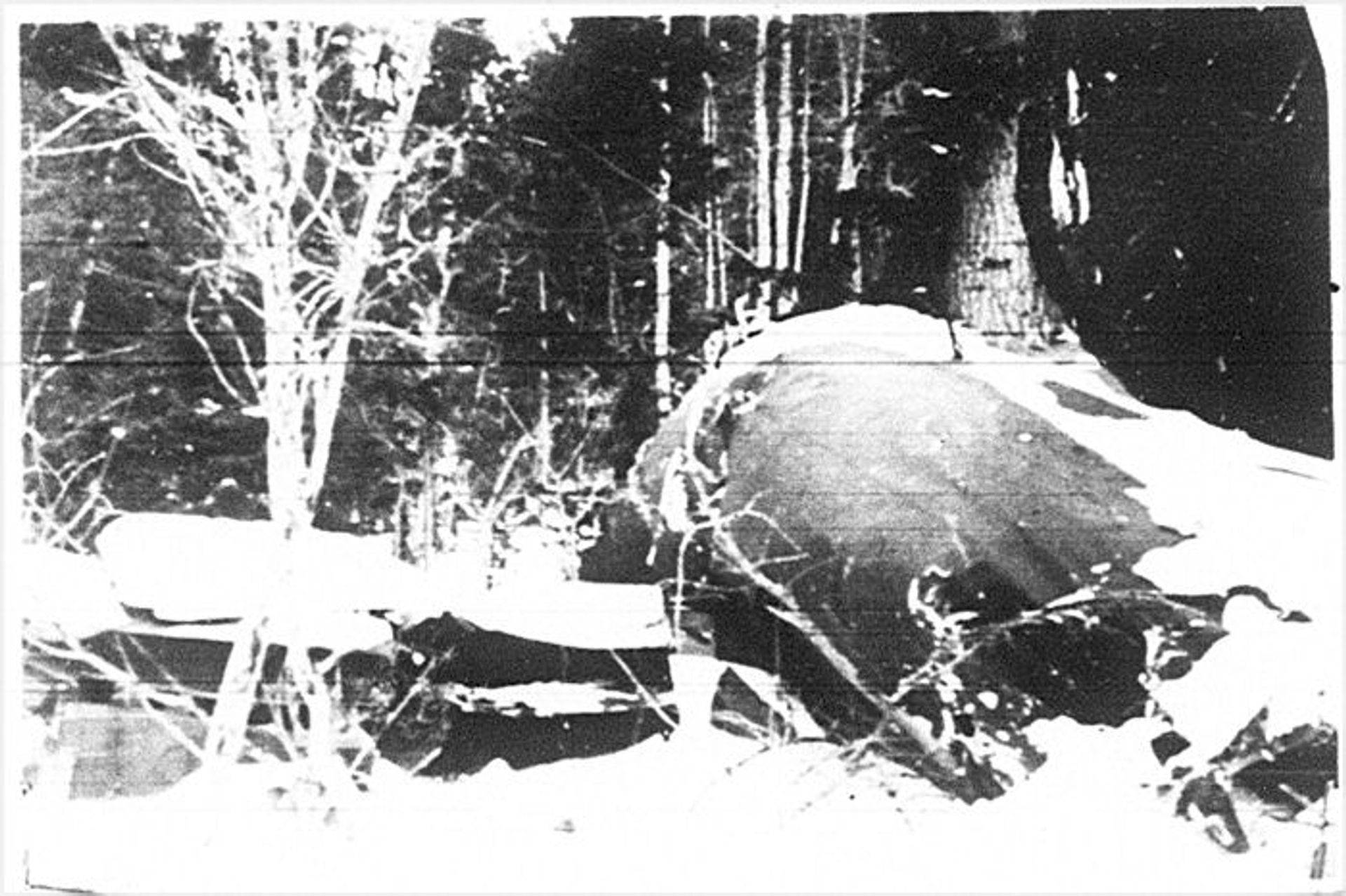
Sgt James E. Fraley – Radio Operator
We were returning from our mission to El Paso, Texas. There was a very heavy overcast and icing on the wings. The radio reception was very poor; in fact inunderstandable.
Our gas supply was very low, so the pilot, Capt. Woodward headed the plane to Las Vegas thinking of landing the plane there. When we passed over Caliente, Nevada, the pilot gave orders to prepare to bail out. I was put in charge of the men to bail out. When the men were all out, I bailed out leaving the pilot and co-pilot in the ship.
As soon as I landed I made my way to town. I called the Tonopah Base and reported what had happened. I received orders from Major La Roche to stay there until further orders.
T/Sgt. Joseph L. Hastings – Passenger
On 4 January 1944, I was aboard plane No. 686 as a passenger. We were on a fuel consumption mission and flew from Tonopah to El Paso, Texas. Take-off time was about 1100 PWT. The weather was clear all the way. I remained in the waist compartment of the plane most of the time. I went to the radio cabin twice during the trip and remained there long enough to get warm. I didn’t know that we were having trouble getting into Tonopah because I did not have an interphone position being an extra man. My first knowledge that we were having trouble was when the oxygen system warning light went on and I went forward to take a tuning unit to the radio operator for the Liaison Transmitter. I helped him tune up the transmitter on 6210 Kcs. To work the tower. About five or ten minutes later the pilot told us to go back and get ready to bail out. We were all ready and waiting to bail out. I was number eight man to bail out when the order came about fifteen minutes later. I landed clear on the level ground about two and a half miles from the highway between Caliente and Panaca, Nevada. I was not hurt, so I started walking towards the highway. I had to walk about a mile out of my way to keep from wading a creek at a wide place. I flagged a passing car and rode to Panaca, going direct to constable Edwards residence. I then called Base Operations at Tonopah and was instructed to remain in Panaca at the telephone to give any further information and to call back when I could give any more information as to whether the other men were being picked up. I gave all the information that I could to the searching parties that were being organized to search for the men.
It was 2000 PWT when I landed, and 2215 when I arrived at the Edwards residence and called the Base.
B-24J-95-CO 42-100366 Z5 B Mizpah

Courtesy: Mark Styling
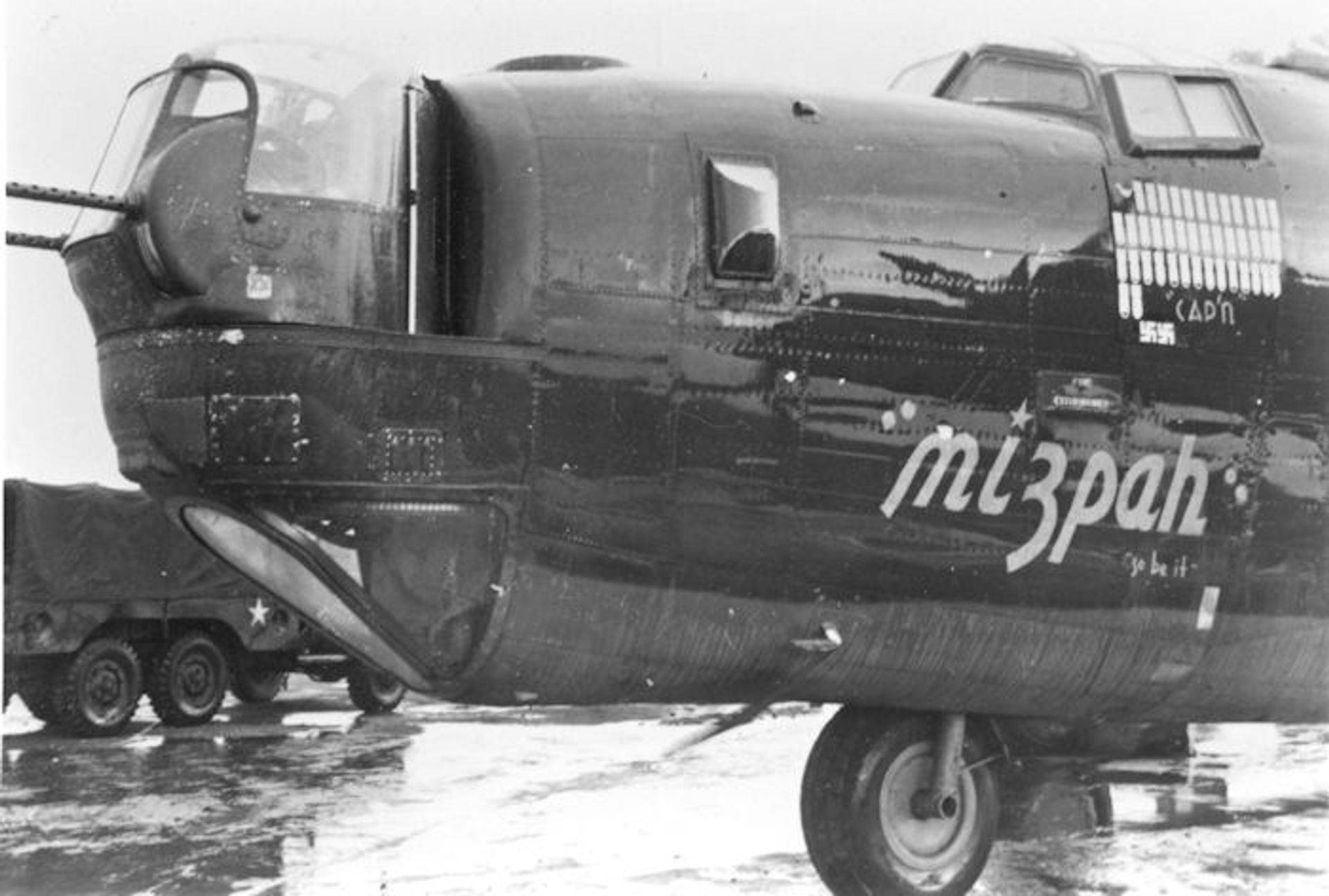
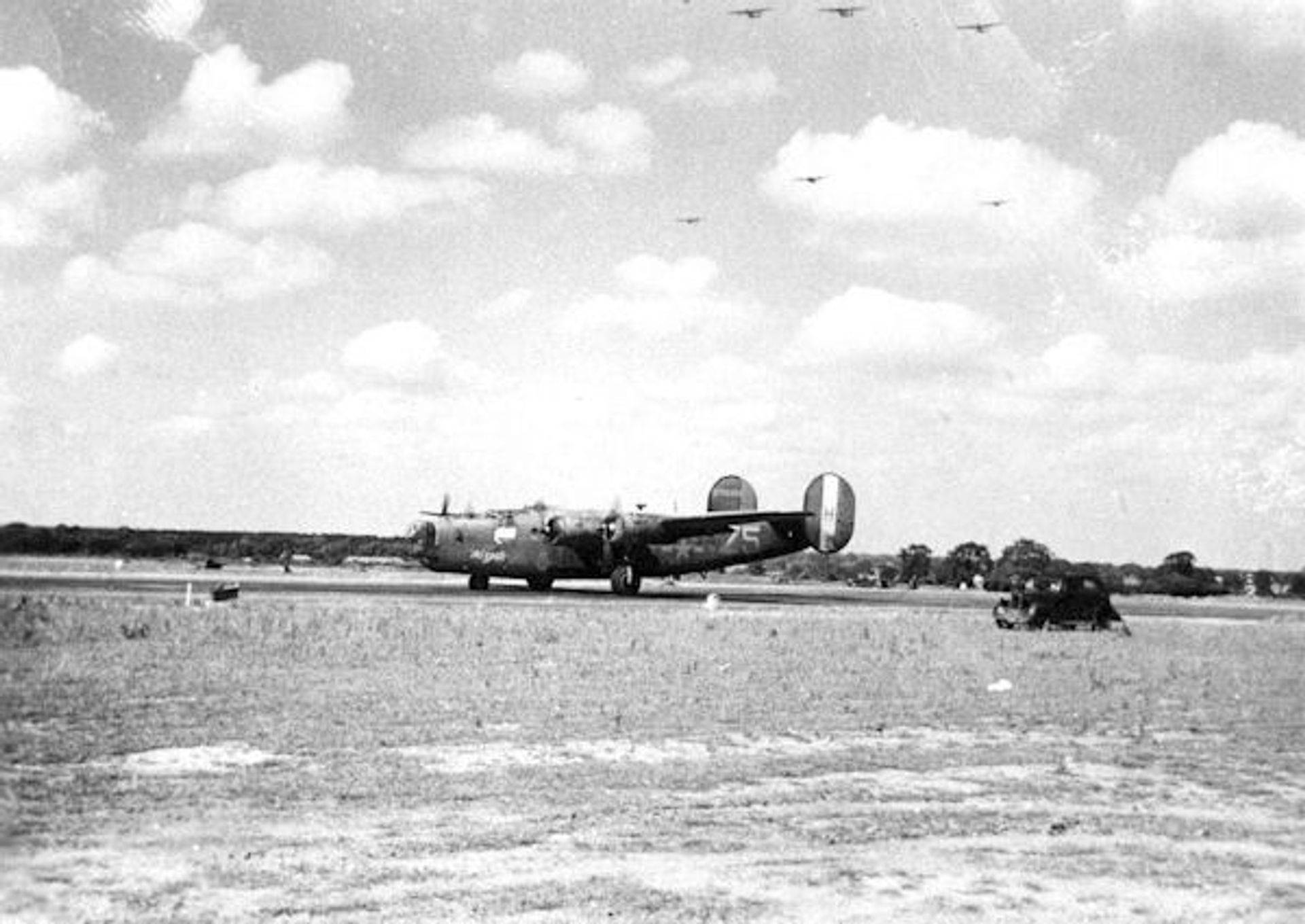

(Photo: Valin Woodward)
Leaving the States – 2Lt Peter A. Zenas


Aviation Cadet – Avon Park, Florida; Crew 41 Co-pilot – Horsham St Faith
My memory also differs as to where we picked up our new B-24. The article said Hamilton AAF, which was North of San Francisco. I recall it was at Sacramento [Mather AAF?]. I am certain of this because of the cockpit glass. The B-24 we lost had domed or blistered side windows that allowed the pilot and co-pilot, or anyone else, to look directly down from the cockpit. Our replacement B-24 had flat glass. I dearly wanted to be able to enjoy the trip to Brazil, Africa, and Europe. I wanted the best view I could get. I wanted domed side windows. I saw an opportunity and I took it. I waited until the civilian workers on the flight line went on lunch break, found a screw driver and ladder, and swapped out the flat windows with domed windows from another B-24. It was probably the fastest cockpit window removal and installation ever.
Later when we got to England, our aircraft was brought up to combat weight. Armored plate and bullet resistant glass was installed. Mizpah being a lead aircraft was fitted with special navigation equipment, and the reliable and desirable Honeywell autopilot, that could be directly controlled by the Norden bomb sight.
Since, our B-4 bags and other gear had been lost with the previous B-24, we had to replace what clothing and other personal items that were needed. Tony replaced his lost Garrison cap. The new one, however, didn’t have the fashionable fifty mission look. Tony removed the stiffening ring, then artificially aged it in the shower stall and by throwing it about. Till at last it reached the desired level of raunchiness. Just because we were green second lieutenants, didn’t mean we had to look the part. Besides, we had already lost a comrade, bailed out, and destroyed a new B-24 bomber – all that and without yet experiencing combat or even leaving the States.
Our trip to England, however, was not without incident. Over the San Joaquin Valley we stuck a seagull, resulting in a large dent to the leading edge of the right wing.
We developed engine trouble shortly after leaving Belem (Brazil) to head out over the Southern Atlantic. One of our engines was throwing oil. Even though it was night, we could see the white smoke as it hit the exhaust. The engine was shut down, the prop feathered, and we returned to Belem. Inspection of the engine revealed that the oil plug had been loosened, and its safety wire had been cut. By all indications someone had attempted to sabotage the engine. We were lucky in that the plug fell out sooner and not later, and that only the one engine had been tampered with.
While our aircraft was being repaired, and inspected to insure that further sabotage or damage had not been done, we were taken to a local beach for some relaxation. Once the bus dropped us off at the beach, we were ordered to strip down to our shorts. Apparently, this was to assure that we won’t leave the beach and go looking for trouble in town. Two, then three hours went by, and still the bus had not returned. The beach was deserted, except for a few fishermen who were using a net to fish from shore. There was nothing within a good mile to provide shade from the tropical sun. At this point we all knew that each of us would be sun burned. The only question was how bad. The severity would depend on when our ride returned. However, with each passing minute, when was seeming more like if. Late in the afternoon somebody apparently remembered about us. The next week was spent in the local hospital recovering from severe sunburn. I was luckier than some, in that I didn’t have second degree burns. When we finally set out across the ocean, I was still in too much pain to don my shoulder harness. I had to sit in a rigid upright position. We had been the last Crew of our Bomb Group to leave the States, and our trip to the beach had cost us an extra week.
t England. There didn’t seem any good reason to hold us at this field for so long, but those were our orders.
Our arrival some two weeks later at Horsham St. Faith was not without incident. We no sooner parked and it became apparent that an air raid was in progress. The Duty Officer greeted us with assurances that the air raid was far enough off, not to worry about. But, if it got any closer, he would show us where the air raid shelter was. At which point some bombs fell closer. “That’s close enough, follow me!” said the Duty Officer.
Aviation Cadet – Avon Park, Florida; Crew 41 Co-pilot – Horsham St Faith
Distinguished Flying Cross
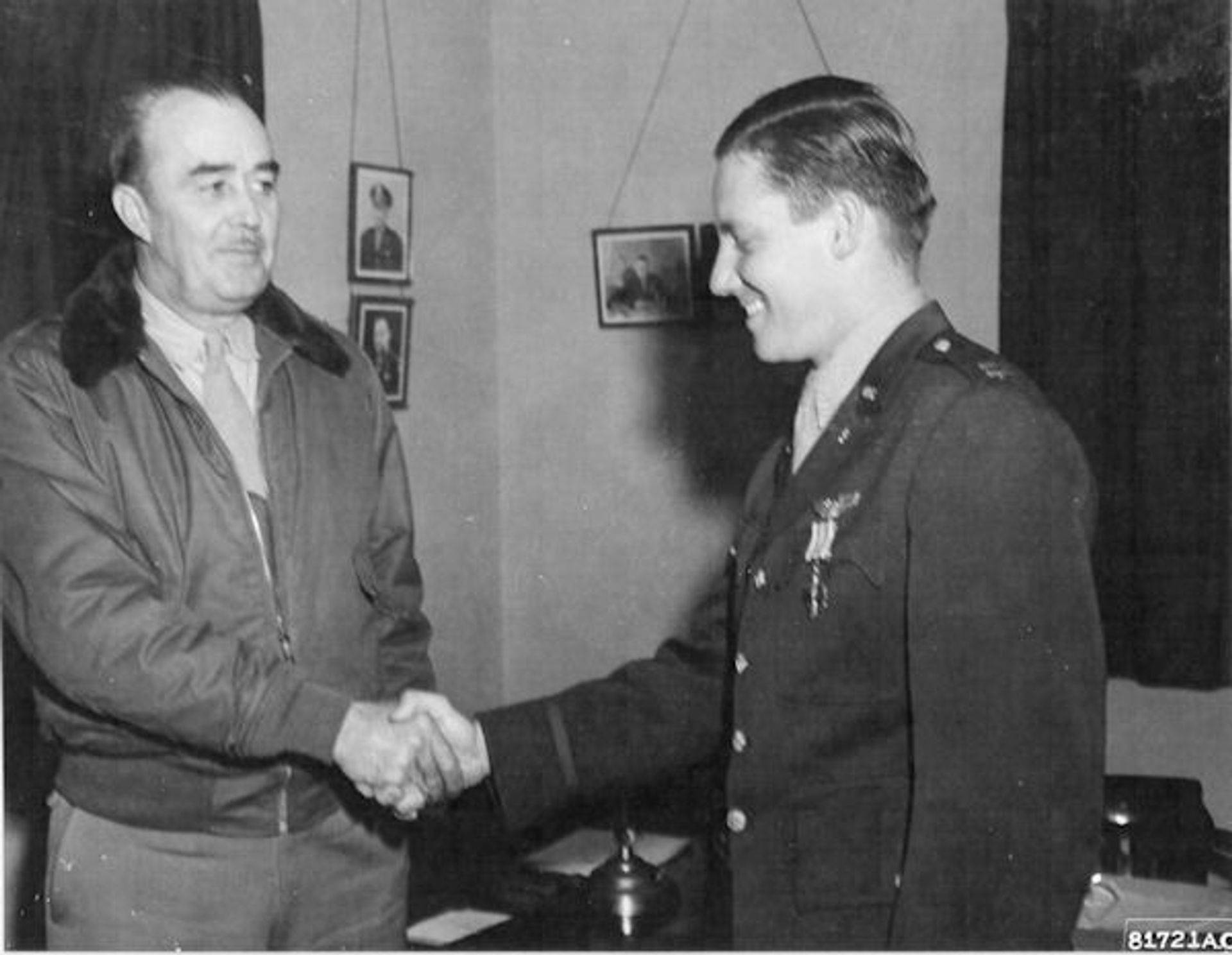
BGen Walter Peck, 96CBW Commander, presents the DFC to Capt Woodward

